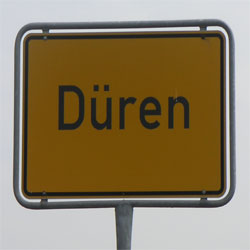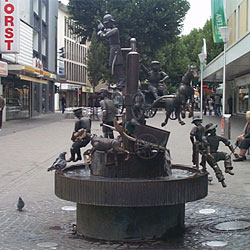Dueren - past and present

Düren's history started probably 200 years ago already. Celts have lived here even before Christ's birth. They called their small settlement Durum (castled). After the Celts other Germanic tribes invaded this area. These were defeated by the Romans under Julius Caesar ('Roman Germania').
Durum was to become a supply area of the fast growing Roman station Cologne. In addition, important Roman transport routes ran past Durum (e.g. the road Cologne - Jülich - Tongeren or the roads Cologne - Zülpich - Trier). The Romans stayed in the area for around 400 years. The description 'villa duria' appeared in the Franconian Reich's annals (Metzer Annals) for the first time in the year 747.

According to August Schoop there was never a Roman settlement in Düren (History of the town Düren. Düren 1923).
After the end of the Roman reign came the Francs to Düren in the 5th-century. The Frankish king Pepin the Short visited the Roman settlement Villa Duria often to hold important meetings here in the 8th-century. The first official mentioning of Düren as Villa Duria stems from the year 747. Pepin was the father of the later famous emperor Charlemagne. The earlier Celtic Durum (= castle) was turned into a Königsburg (king's castle) by the Franks, which they called Pfalz (imperial palace) and where Charlemagne (742-814) often stayed. It was located where the Anna church is now. Soon, due to the often visiting Charlemagne lots of markets, e.g. grain market, cattle market, wood market, chicken market, butter market was created, which contributed to Düren's boom.
Düren receives its town charter at the beginning of the 13th-century. Around 1200 the construction of a town wall started. Part of the town wall were 12 town towers and 5 town gates. The town gates were located in all 4 cardinal points. They were: in the north the Philipp's gate and the Wirtel gate, in the east the Cologne gate tor, in the south the Ober gate and in the west the Holz gate (today only ruins of the town towers exist).
In the year 1501 the stonecutter Leonhard pilfered a small box with relics of the Holy Anna from the Mainzer collegiate church St. Stephan and brought those to Düren. Pope Julius II decided on the 18th of March 1506, that Düren may keep the mortal remains. They were kept in the Martin church, which was renamed to Anna church in 1505. Officially, the church might have been renamed much later, it was still called parish church St. Martinus in the 19th-century. The Holy Anna was Düren's patron saint. Every year, the saint's day of the holy Anna (26. Juli) is being celebrated for a week, with the Annaoktav, a parochial celebration and the Anna fair, one of Germany's biggest folk festivals.
After William IV [V] Count of Jülich started a war against Charles V, Holy Roman Emperor in 1542, Düren was besieged by the imperial troops in 1543. These entered the town and set it alight, robbed and looted the town. The rebuilding took some time and the Anna church was finished in 1563.
In 1642 Düren was also involved in the Thirty-Year War. enemy troops destroyed and devastated the town. When the war finally ended in 1648, the plague broke out and many people died. A second plague epidemic broke out in 1665. During different attacks onto the weakened town, Düren was once again in parts destroyed in 1679. At this time, Miesheim was also destroyed and never rebuilt.
At the end of the year 1755 a series of earthquakes started in the area of Düren and Aachen, which reached its peak with a magnitude of 8 on the Richter scale near Düren on the 18th of February 1756. It was an earthquake series, which was felt in the whole of Europe with the most famous example Lisbon.
Since the 15th-century economic life in the Düren area is being determined by textiles (cloth) and metal business (iron). At the beginning of the 17th-century paper manufacturing came, benefitting from the unusual soft water of the Rur. In 1710, Rütger von Scheven constructed the first paper mill in Düren. In 1812 there were already 17 paper factories, 11 cloth and blanket factories, a steel mill and two iron foundries in Düren.
In the year 1794 Düren was occupied by troops of the French Revolution. From 1798 to 1814, it was the pricipal place of a same-named cantons in the arrondissement Aachen of the French Roer department. Through descisions of the Congress of Vienna it came to Prussia in 1815.
Around 1900, Düren counted as one Germany's most affluent towns (42 millionaires lived here and there were 93 manufacturing businesses) and as the second-rich city in Prussia. In 1805, 4563 citizens lived here, in 1900 it was 27.168 citizens already.
On the 16th of November 1944 Düren was completely destroyed through an allied attack in World War II. Around 22.000 people lived at that time in the town. Of those, 3.000 died during the bombing raid. To continue living here in the more or less completely bombed town wasn't possible anymore. The Düren citizens who were still alive had to leave their home and were evacuated to central Germany. Only 4 people lived in Düren after the air attack.
In 1945 the town was located in the main battle front. On the 25th of February 1945 the American troops crossed the Rur near Düren. After the war ended many of the evacuated Dürener returned to their destroyed town in the summer of 1945 already. They started rebuilding against the recommendation of the American occupier. In June 1945 already 3806 citizens had returned to Düren. This is the reason for Düren's fifties style architecture.

